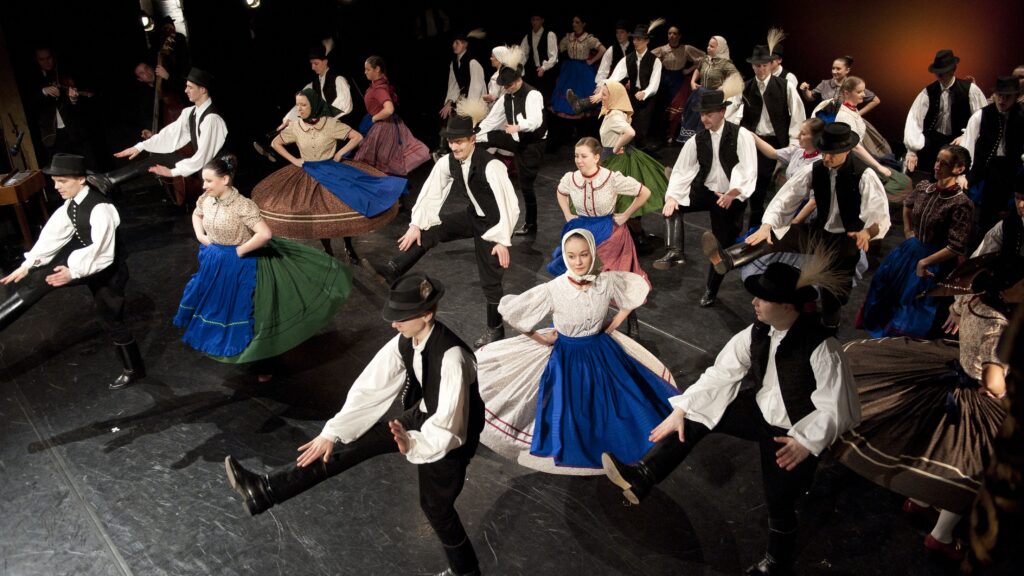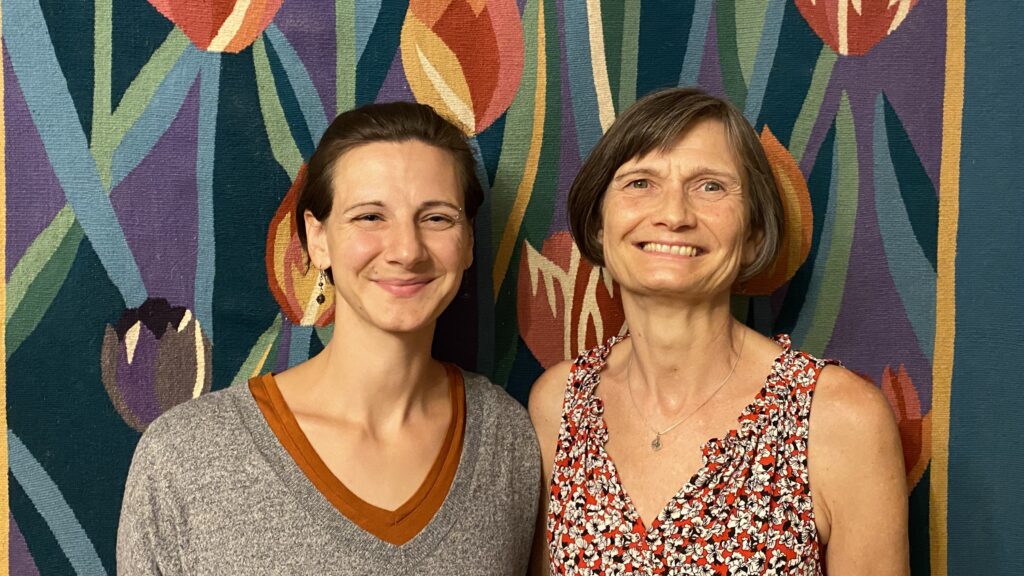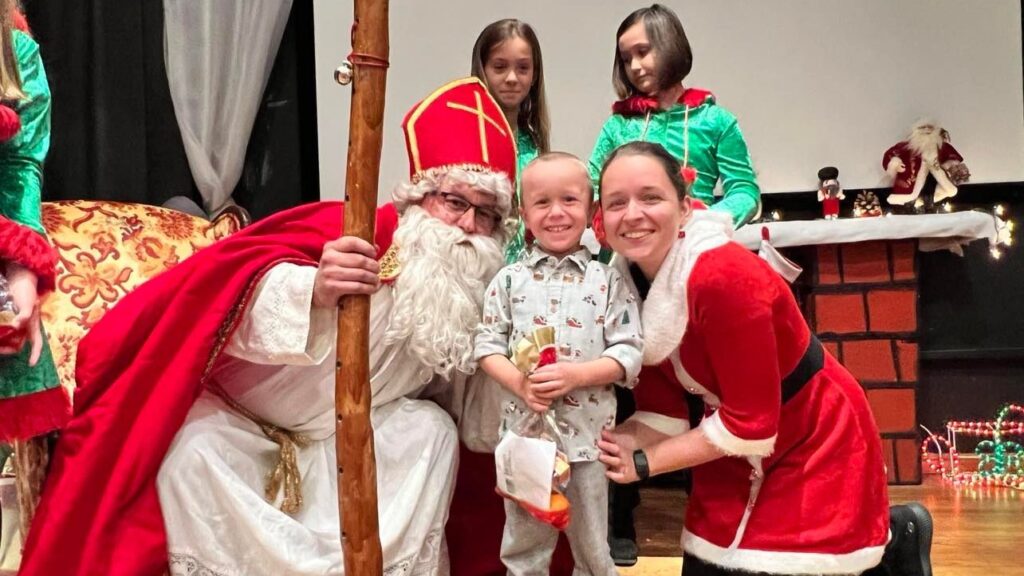22-year-old Bence Zsolt Hajdu follows the footsteps of his parents while dancing and teaching folk dance ensembles at Isaszeg and Dány, near Budapest, Hungary. He is currently a student at the Hungarian Dance University, and applied for a Kőrösi Csoma Sándor Program (KCSP) scholarship last year along with her classmate and fellow dancer, Kíra Kleopátra Kertész. Bence spent last year in Washington, DC, while Kíra was based in Seattle, WA, but this year they plan to travel together across the U.S. in a pioneering way as ambassadors of the Hungarian Folklife Association (HFA).
***
What did you do before you came to Washington, DC with the Kőrösi Csoma Sándor Program scholarship?
I was born in Budapest in 2002 and live in nearby Isaszeg with my parents and siblings. My parents, Zsolt Hajdu and Ildikó Hajduné Bilász, were dancers in the Csata Táncegyüttes in Isaszeg, and later worked as folk dance teachers. For 15 years I continuously learned from them, first dancing, and then how to create choreographies, teach and manage rehearsals. I graduated from the Vocational High School of Folk Arts in Fót, majoring in folk dance. In 2019, one of my former high school teachers offered me a job in the Ördöngős Dance Group in Dány, a neighboring village, which I couldn’t accept because of my studies, so I passed the opportunity on to my parents. We’ve all been dancing and teaching in Dány since 2020. I currently work as a rehearsal assistant and dance director, but I also help with the choreography. I’m a student at the Hungarian Dance University, but I suspended my studies because of the KCSP scholarship. I still have one year left before graduation, so I should write my thesis; I have done the research, but at this point I don’t have enough time to write.

Your love of folk dance and teaching comes from your parents. Was it always natural for you to continue this family heritage in a professional way?
As a child, I didn’t want to dance at all. I felt that my parents were forcing me; I wanted to be a dentist at the time. This lasted until one day my grandmother asked me the question: ‘Bence, don’t you want to do folk dancing?’ It was only then when I started thinking thoroughly about it and finally answered yes. After that, I began to take it more seriously and tried to develop my inherited talent. Every year between 2013 and 2019 I went to regional and national children’s and youth solo folk dance competitions. Fortunately, I never came home with empty hands, I always managed to win some awards. That’s when my love for folk dance really started. From 2019, I didn’t participate in competitions anymore, I felt more and more that I should be teaching. I’ve always loved working with children and adults, teaching not only dance, but anything else. I once had a strange inclination towards logistics, working as a warehouse manager, because I needed extra income, but the main direction was always folk dancing.
Why did you apply for the KCSP scholarship and why to Washington, DC?
In May 2023 my dear friend and partner dancer Kíra Kertész noticed an ad on Instagram by Anna De Checke Qualls, aka Panni, that the Tisza Dance Company of Maryland was looking for a KCSP scholar, a man or a couple. Kíra sent me the ad asking us to apply. I agreed to give it a try, we wrote to Panni, sent her our resumes, and applied to the program at her suggestion. I met Kíra back in 2016, we were classmates in high school, later we were colleagues at university, we danced together and constantly supported each other. We applied for the KCSP scholarship as a couple, but ended up in separate places: she was assigned to Seattle, WA, while I went to DC. When I arrived, I was very afraid of how I would be received, whether they would love me, whether I would be able to do everything on my own, including dance teaching. In retrospect, I can say that I was very pleasantly surprised. My perceptions of the American environment in general completely changed after spending nine months there, during which I mainly worked with the Tisza Dance Company of Maryland, the local scout team in Washington, DC and the Hungarian American Coalition (HAC). I have very good experience with every organization I worked with.

What about Kíra?
Kircsó is a very special girl, with a slightly abstract personality, who, in addition to folk dancing, also performs acrobatic rock and roll at a high level: her team became European and world champions. When she got to Seattle, she immediately started to map the Hungarians in the area, she went to several places to dance, and even held online training sessions for parents, while she also had quite a lot of KCSP-related tasks. She also worked for three organizations: the Seattle Dance Group, the Hungarian Association of Washington and the Hungarian School. She was very active and therefore loved everywhere.
We’ll come back to that, but now let’s take a look at the organizations you worked with. Let’s start with Tisza, which was founded by non-Hungarians.
Yes, the founders of the Tisza Dance Company are an American couple who attended the Nyírség Dance Ensemble in Hungary for three or four years and learned Hungarian there. I can safely say about Cathy Lemont that she speaks Hungarian better than some Hungarian Americans. When I arrived, I didn’t even notice she wasn’t Hungarian. Unfortunately, I didn’t get to meet her husband, because he had passed away. Cathy alone continues managing the ethnically mixed group, which has more Americans than Hungarians as members, a total of eight couples. Since several of them are quite old by now, my main task was to recruit new, younger members. This was achieved with monthly youth dance hall events (táncház) and various other programs. We constantly invited them to, for example, the Scout Ball, the Hungarian Bazaar, and the Hungarian Days. At every event, there were dance lessons or some kind of cultural contest, and we finally managed to bring in eight young people, six girls and two boys as new members. Hungarians in the Washington area are very scattered. In addition to recruiting new members, teaching folk dances was my other main task. I managed to teach three new choreographies, which they successfully performed in Washington, DC, Baltimore, Virginia, and New Jersey. At the Hungarian Festival in New Brunswick, New Jersey, except for one, only their new choreographies prepared in the past year were presented.

How did teaching work for the scouts? That’s not always easy…
As far as I know, after the scouts in Cleveland and New Jersey, this Virginia scout team is the largest by size. I was also very lucky, because these children who came to me really wanted to learn folk dance. This is how the local Regősök Dance Group was re-formed, with 22 young people between the ages of ten and fourteen, with a perfect split of 11 boys and 11 girls. The predecessor of this group was the Rózsafa Dance Company, led by Zsuzsanna Seres for several years, which ceased to operate due to lack of new joiners. However, an adequate age group has grown up again by now, who have the desire to practice folk dance. Our goal was one big performance, but it turned out to be two, namely the Hungarian Day festival in Virginia and the other similar one in New Brunswick. I can say that we overachieved, which is a big achievement, because all but four dancers were beginners. We were lucky that we could inherit the bulk of the folk dance clothes mainly from our predecessors.
Young children performed at this year’s Hungarian Heritage Day in DC. Did you teach them, too?
No. Weekly folk dance lessons are organized for small children, not only for scouts at the Kossuth House, led by two dancers from Tisza. They had an idea, which I helped to further develop, i.e. I supported them professionally.

And finally: what was your task at the HAC?
That was the only organization where I couldn’t really help. They would have needed a specialist in marketing graphics, which I wasn’t, so I could mainly help them with logistical tasks, such as taking inventory, preparing presentations and the organization’s calendar.
Panni was your mentor. Could you introduce her briefly?
Panni is a permanent member of the Tisza Dance Company and is mainly responsible for finances and event organizing. Panni has goals, resources and energy that very few people have. If she decides about something, she carries it out, be it any idea or program. She fights for opportunities, including financial ones, until they come true. She helped me a lot, too. I’m certain that in her I had the most helpful and most supportive mentor.
It was so great for you in Washington, DC and with Panni that you plan to come back…
Yes, but now I’m entrusted with a different task. During the year, together with Panni, we came up with an unusual idea: there are many Hungarian communities that cannot claim a KCSP scholar for nine months, only maybe for a few weeks, a weekend or for a particular event. In many places there is some level of Hungarian folk cultural life, even if rudimentary, but in many others there’s nothing like that. To our great pleasure, Panni, through the Hungarian Folklife Association (HFA), founded by Kálmán Magyar Jr., managed to convince the State Secretariat in charge of policies for Hungarian communities abroad about the idea of a ‘traveling KCSP’ position. Kíra and I were asked to be the first Folklife ambassadors, which we gladly accepted.

Where are you planning to travel and what can you offer?
What we can provide is mainly folk dance lessons, but also many other folklife related projects: folk song lessons, organizing events and children’s programs, starting or developing folklife. We put together the travel calendar with the HFA in such a way that we have to spend as little time traveling as possible. There will probably be an East Coast, a West Coast, a Canadian, etc. tour. Fortunately, we receive support for the trips, local travel and accommodation from the HFA as well as the host organizations. We have roughly mapped the needs, we have contacted and keep communication with 16 organizations so far; including some in Chicago, Portland, Dallas and multiple locations in Virginia, Maryland, North and South Carolina, and Canada. Panni and HFA welcome further applications from other Hungarian communities to extend this program.
Read more Diaspora interviews:








